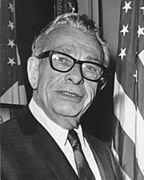United States Senate elections, 1960 and 1961
|
|
||||||||||||||||||||||||||||||||||||||||
|---|---|---|---|---|---|---|---|---|---|---|---|---|---|---|---|---|---|---|---|---|---|---|---|---|---|---|---|---|---|---|---|---|---|---|---|---|---|---|---|---|
|
||||||||||||||||||||||||||||||||||||||||
|
35 of the 100 seats in the United States Senate 51 seats needed for a majority |
||||||||||||||||||||||||||||||||||||||||
|
||||||||||||||||||||||||||||||||||||||||

Results including special elections
Democratic gain Republican gain Democratic hold Republican hold |
||||||||||||||||||||||||||||||||||||||||
|
||||||||||||||||||||||||||||||||||||||||
The United States Senate elections of 1960 (and a subsequent special election in 1961) coincided with the election of John F. Kennedy as president. The Republicans gained one seat at the expense of the Democrats. The Democrats nonetheless retained a commanding lead in the Senate with 64 seats to 36. As Majority Leader Lyndon B. Johnson was elected Vice President, Mike Mansfield became the new Majority Leader.
The Republicans' net gain of one seat was eliminated after the election.
The Republicans gained one seat early in the next Congress.
The Republican Senator-elect from Wyoming died between the election and the next Congress. A Democrat was appointed in his place by the beginning of the next Congress.
In these special elections, the winner was seated during 1960 or before January 3, 1961; ordered by election date.
In these general elections, the winners were elected for the term beginning January 3, 1961; ordered by state.
All of the elections involved the Class 2 seats.
In these special elections, the winners were seated after January 3, 1959.
...
Wikipedia


